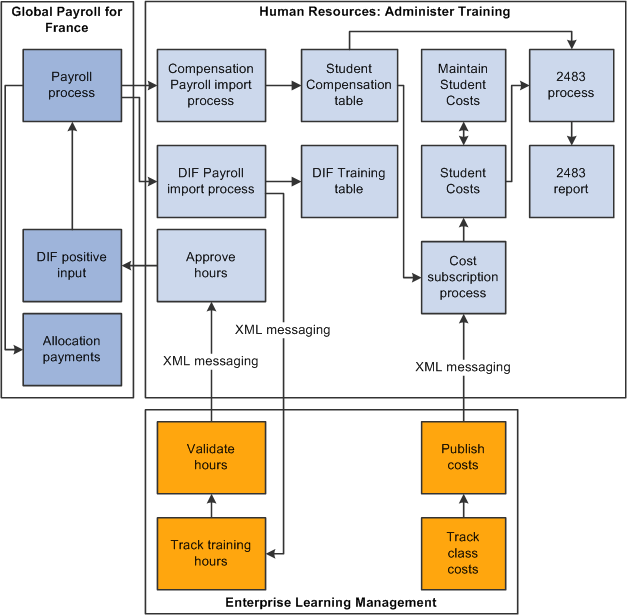Understanding Integration with Enterprise Applications
Enterprise Learning Management integrates directly with the Administer Training business process in HR 8.9 and above and indirectly with Global Payroll for France 8.9 and above, enabling you to produce the 2483 report, track DIF balances, and compensate learners for DIF training hours and training hours done outside the normal work schedule. The three applications interact as follows:
Enterprise Learning Management is the application that you use to set up the learning catalog, instructors, vendors, and so on. You also use this application to track learning costs and to manage enrollment and other day-to-day tasks.
The Administer Training business process in HR compiles information provided by Enterprise Learning Management and payroll and generates the 2483 report.
Global Payroll for France computes learner and instructor salaries for the 2483 report and calculates learners' DIF entitlement balances.
It also calculates the salary for training hours done outside of normally scheduled work hours.
Important! When you use Enterprise Learning Management to set up and track learning, do not use the Administer Training business process for those tasks. Use the Administer Training business process to configure and generate the 2483 report only. A permission list designed for Enterprise Learning Management users provides access to the Administer Training pages that are needed to set up and generate the 2483 report.
Image: Enterprise Learning Management Integration with Global Payroll for France and HR
This diagram shows the relationships between Global Payroll for France, HR: Administer Training, and Enterprise Learning Management.

Enterprise Integration Points (EIPs)
Enterprise Learning Management uses EIPs to publish information to HR and to subscribe to information provided by that application. Following is a list of the full sync and incremental sync EIPs that are used to track learning costs and hours.
Note: The full sync messages can generate a high volume of data. Use these messages only if you need to resynchronize HR data and Enterprise Learning data during the integration process.
|
Message Name |
Message Subscription PeopleCode |
Records Populated in Enterprise Learning Management |
Explanation |
|---|---|---|---|
|
TRAINING_HOUR_SYNC (incremental sync) TRAINING_HOUR_FULLSYNC (full sync) |
Not applicable |
Not applicable. |
Outbound message that publishes validated training hours and DIF information to HR. The incremental sync message is triggered by the LM_STD_HOUR Application Engine process that is launched through the Export Learning Hours page. The full sync message is triggered from an option on the same page. |
|
TRN_HOUR_ACK_SYNC (incremental sync) TRN_HOUR_ACK_FULLSYNC (full sync) |
DEFAULT |
LM_STG_TRKHOUR (staging table) LM_ENR_LC_TBL |
Incoming message from HR. The message retrieves an acknowledgement of action taken in HR and updates the Hour Tracking Status field on the Validate Training Hours page. |
|
DIF_BALANCE_SYNC (incremental sync) DIF_BALANCE_FULLSYNC (full sync) |
DEFAULT |
LM_STG_DIFHIST (staging table) LM_DIFHIST_TBL |
Incoming message that subscribes to the DIF balance information computed by the payroll engine. DIF balances appear on the enrollment pages. |
|
STUDENT_COST_FULLSYNC (incremental sync) STUDENT_COST_SYNC (full sync) |
Not applicable. |
Not applicable. |
Outbound message that publishes cost data to HR for inclusion in the 2483 report. Message is based on the LM_ENRLMT_COST table. The incremental sync message is triggered by the LM_STD_COST Application Engine process that is launched through the Export Learning Cost page. The full sync message is triggered from an option on the same page. |
|
COST_ACK_SYNC (incremental sync) COST_ACK_FULLSYNC (full sync) |
DEFAULT |
LM_STG_TRKCOST (staging table) LM_ENR_LC_TBL |
Incoming message that subscribes to the cost acknowledgement sent by HR. This message includes a status field that informs the administrator about the action done by the HR administrator. |
EIPs and Staging Tables
Data that is imported through incremental sync EIP messages (DIF balances, and acknowledgements for the receipt of learning costs and hours) goes into intermediary staging tables. You must run a validation process to ensure that there are no data errors before loading the data into the system. You can run this process, as needed, and also schedule it to run on a regular basis using the Process Asynchronous Data page.
It's recommended that you do not select the option to Automatically delete completed process. Administrators can then periodically review the staging table for data that could not be loaded due to errors and purge the staging tables by manually launching the delete process. For example, if you schedule the asynchronous process to run daily, the administrator may want to check the staging table for errors every few days. If no errors exist, the administrator can launch the process with the delete option selected.